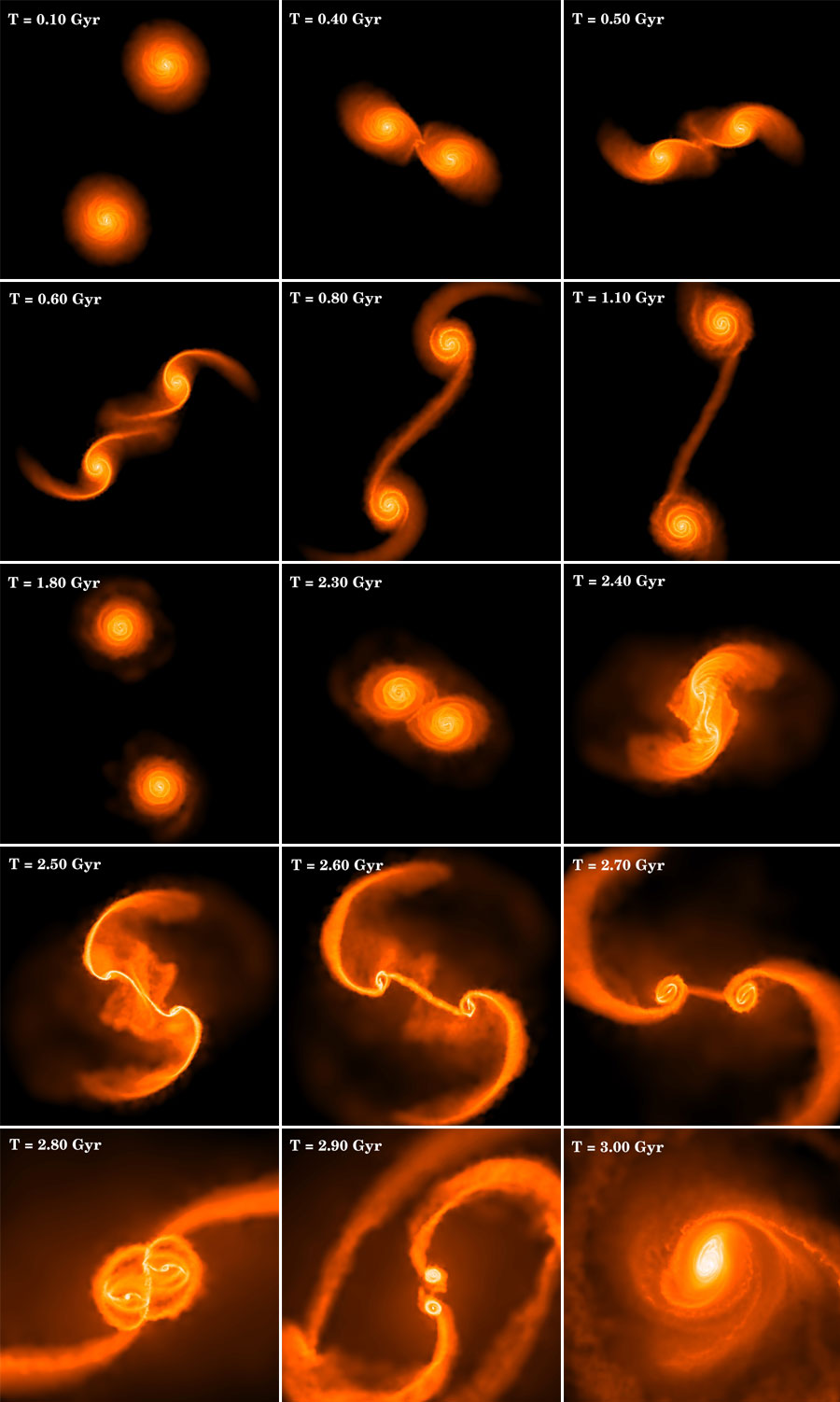A new model seeks to turn that idea on its head. And the researchers say the very large umbrella of 'dark matter' may be the explanation.
Writing in Nature, the researchers describe computer simulations in which they modeled the evolution of galaxies and black holes during the first few billion years after the Big Bang. Their results say the first-ever super-massive black holes were likely born when those early galaxies collided and merged together.
"Amazingly, this is contrary to hierarchical structure formation," says Ohio State University astronomer Stelios Kazantzidis. "The paradox is resolved once one realizes that dark matter grows hierarchically, but ordinary matter doesn't. The normal matter that makes up visible galaxies and super-massive black holes collapses more efficiently, and this was true also when the universe was very young, giving rise to anti-hierarchical formation of galaxies and black holes."
So when it comes to normal matter, big bits like giant galaxies and super-massive black holes come together quickly, and smaller bits like our own Milky Way galaxy -- and the comparatively small black hole at its center -- form more slowly. The galaxies that formed those first super-massive black holes are still around, Kazantzidis added.

The complexity of dynamical evolution in a typical collision between two equal-mass disk galaxies. The simulation follows dark matter, stars, gas, and supermassive black holes, but only the gas component is visualized. Brighter colors indicate regions of higher gas density and the time corresponding to each snapshot is given by the labels. The first 10 panel images measure 100 kpc on a side, roughly five times the diameter of the visible part of the Milky Way galaxy. The next five panels represent successive zooms on the central region. The final frame shows the inner 300 pc of the nuclear region at the end of the simulation. Credit: OSU
They started their simulations with two giant primordial galaxies, ones made of the kinds of stars that were around at the beginning of the universe. Astronomers believe that back then, all stars would have been much more massive than present-day stars, up to 300 times the mass of our sun. Then they simulated the galaxies colliding and merging together.
Previous simulations showed details of the merged galaxy down to only about 300 light-years across but their new simulations contained features that were 100 times smaller, and revealed details in the heart of the merged galaxies on a scale of less than a light year.
They say their simulation saw two things happen. First, gas and dust in the center of the galaxies condensed to form a tight nuclear disk. Then the disk became unstable, and the gas and dust contracted again, to form an even denser cloud that eventually spawned a super-massive black hole.
The implications for cosmology are far-reaching if their computer model is accurate, Kazantzidis said. "For example, the standard idea -- that a galaxy's properties and the mass of its central black hole are related because the two grow in parallel -- will have to be revised. In our model, the black hole grows much faster than the galaxy. So it could be that the black hole is not regulated at all by the growth of the galaxy. It could be that the galaxy is regulated by the growth of the black hole."
On the video, during the interaction, violent tidal forces tear the galactic disks apart, generating spectacular tidal tails, plumes and prominent bridges of material connecting the two galaxies. The ultimate outcome of a series of increasingly close encounters is the inevitable merger of the disk galaxies into a single structure and the formation of a nuclear disk as shown in the last panel. The simulated nuclear disks have masses of approximately a billion solar masses and exhibit prominent non-axisymmetric features known to produce strong gas inflows. The gas inflows are likely responsible for fueling the central black hole, but even higher resolution will be needed to study this process in detail. Nevertheless, the simulations carried out by Kazantzidis and his collaborators provide the first direct evidence that gas originally in galaxies separated by hundreds of kiloparsecs is collected to sub-parsec scales simply as a result of the dynamics and hydrodynamics involved in the merger process. Credit: University of Zurich
What might this mean for direct evidence of Einstein's theory of general relativity, gravitational wave? According to general relativity, any ancient galaxy mergers would have created massive gravitational waves, ripples in the space-time continuum, the remnants of which should still be visible today. New gravitational wave detectors, such as NASA's Laser Interferometer Space Antenna, were designed to detect these waves directly, and open a new window into astrophysical and physical phenomena that cannot be studied in other ways.
Scientists will need to know how super-massive black holes formed in the early universe and how they are distributed in space today in order interpret the results of those experiments.
This work was funded by the Swiss National Science Foundation, the Center for Cosmology and Astro-Particle Physics at Ohio State, and the Kavli Institute for Particle Astrophysics at Stanford University. Simulations were performed on the Zbox3 supercomputer at the University of Zürich and on the Brutus cluster at ETH Zürich.
Citation: L. Mayer, S. Kazantzidis, A. Escala, S. Callegari, 'Direct formation of supermassive black holes via multi-scale gas inflows in galaxy mergers', Nature 466, 1082-1084 (26 August 2010) doi:10.1038/nature09294






Comments